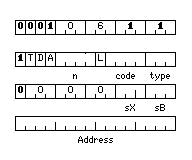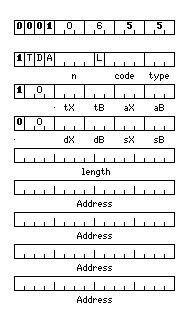
The illustration below shows the format of the DET instruction.

The DET (Define Extended Translate) instruction defines one of sixteen programs (which one is indicated by the n field of the instruction) for a given operand type (as defined by the type field of the instruction), a given code format (as defined by the code field of the instruction) and combination of parameters (as indicated by the L, D, T, and A bits of the instruction).
These programs are used for the EET (Execute Extended Translate) instruction, the format of which is shown below:

The purpose of this instruction is to provide the ability for the user to define character operations that the computer will perform at a higher speed than if they were done explicitly through normal instructions. The capabilities provided by this instruction have been very closely modeled on those offered by the IBM 7950 computer, also known as HARVEST, but the original design of the instruction was independent; since then, having located information on that computer which has been made public, some limited attempts have been made to incorporate some features from its design as well.
These instructions are available from Normal Mode and Compact Mode. From Simple Mode, the DET instruction begins with 046110 instead of 010611, and the EET instruction begins with 046550 instead of 010655.
At this time the format of programs for this instruction is only defined for code formats 0 and 12.
For code format 0, the type field is defined to have the normal significance:
000: Byte 001: Halfword 010: Integer 011: Long 100: Medium 101: Floating 110: Double 111: Quad
For other code formats, the type field may have a different significance; particularly, a code format may be defined in which the operands to the instruction consist of a series of strings or vectors, rather than a string of scalar values.
But for this code format, the program format is defined for all combinations of parameters. Other values of the code field may indicate a different form of program, and other values of the type field for the any given value of the code field may indicate a substantially similar code format, modified only as much as is necessary to handle the different data type. Also, for other values of the code field, the length parameter of the instruction may have a different function than initializing a counter usually intended to determine the number of iterations of the procedure.
The instruction performs a user-defined operation which may have up to five parameters, four of which are optional, and one of which is immediate.
The instruction always has a source parameter.
The source operand of the DET instruction is the program that this instruction, the EET instruction, will execute.
The format of the program which is the operand of a DET instruction in code 0 will be described in the next section.
Following that, the operation of the system with code 12 microprograms will be described; instead of translating a character string, they perform interpretive execution of program code, and thus the DET and EET instructions are themselves significantly modified when code 12 is chosen.